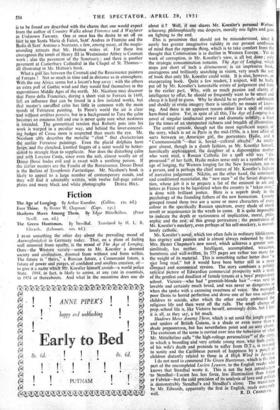Art of Italy
The Cosmati. By Edward Hutton. (Routledge and Kegan Paul. Li is.) The Painters of Ferrara. By Benedict Nicolson. (Paul Elck. Li is.) ALTHOUGH the Cosmati worked in a far less peaceful era than ever disturbed the court of Ferrara, no traces of unrest are apparent in their labours. These Roman marble-workers of the twelfth and thirteenth centuries created a harmony-of design in their patterned marble mosaics that few artists have since been able to rival. The most successful attempts in abstract art to reduce painting to a coloured geometrical formula fall very far short of the achieve- ments of these early decorators, who only used their serene patterns as an accessory with which to accentuate the proportions of a completed structure—whether for an episcopal throne, an altar, a ciborium, a cloister, a portico or a pavement. Mr. Hutton, who was responsible for the pavements in St. Paul's Chapel of Westminster Cathedral and in Buckfast Abbey Church, has written the first monograph in English on these Roman artists, and no one better suited could have undertaken the task. The little- known and remote churches where much of the best Cosmati v,ork
is to be found are described with the charm that one would expect from the author of Country Walks about Florence and A Wayfarer in Unknown Tuscany. One at once has the desire to set off on fOot to see Santa Maria di Faleri, Sant' Andrea in Flumine and the Badia di Sant' Antimo a Nuzzano, a few, among many, of the magic- sOunding retreats that Mr. Hutton writes of. For those less eourageotis the tomb of Henry 111 in Westminster Abbey is Cosmati work ; also the pavement of the Sanctuary ; and there is another pavement at Canterbury Cathedral in the Chapel of St. Thomas— all illustrated in Mr. Hutton's book.
What a gulf lies between the Cosmati and the Renaissance painters of Ferrara ! Not so much in time and in distance as in atmosphere. With,the one Africa seems but a locust's hop away ; with the others an extra puff of Gothic wind and they would find themselves in the superstitious Middle Ages of the north. Mr. Nicolson may discover that Piero della Francesca, during a short visit to Ferrara in 1449, telt an influence that can be found in a few isolated works, but that master's unruffled calm has little in common with the main trends of Feriarese painting. In Piero's world the air is clear 'and winput arrieres pensies, but in a background to Tura the calm beeoptes an ominous lull and one is never quite sure what nastiness is. intended. The geometrical tension that Roberti puts into his work is warped in a peculiar way, and behind the lover-conceal- ing, hedges of Cossa more is suspected than meets the eye. Mr. Nicolson ably describes the metallic "clink " that characterises the earlier Ferrarese paintings. Even the placid dolphins have fangs,-and the clenched, knotted fingers of a saint would be better- Ohne& to strangle than to supplicate. Nor does the disturbing calm end with Lorenzo Costa, since even the soft, almost woolly air of Dosso Dossi bodes evil and is sweet with a soothing poison. If the earlier masters arc the Fuselis of the Renaissance, Dosso Dossi is the Berlioz of Symphonie Fantaslique. Mr. Nicolson's book is likely to appeal to a large number of contemporary minds, and they will find it admirably written, with twelve full-page colour
plates and many black and white photographs DEREK HILL.



































 Previous page
Previous page